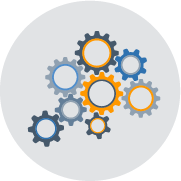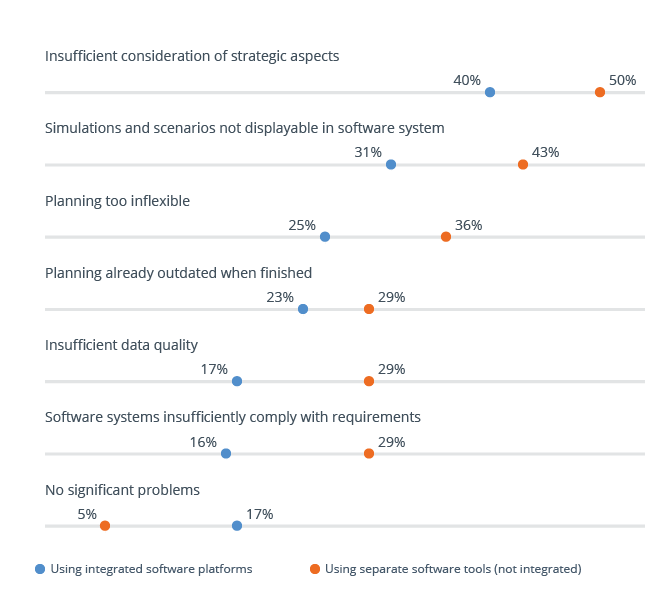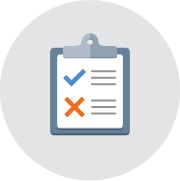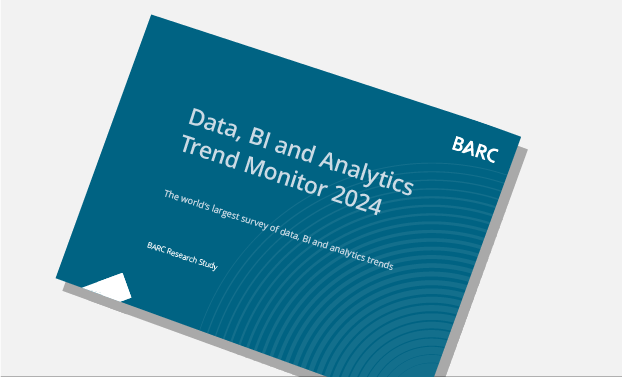The simplest definition of management is to plan, steer and control an organization’s performance. Planning and controlling this performance relies on the analysis of the past outcomes of operational processes. Decisions are taken at many levels – strategically, tactically and operationally – and include data about the past (e.g. in reporting), about processes currently running (in activity monitoring) but increasingly also about the future (in planning, forecasting and predictive analytics).
Decisions should also be aligned with the organization’s vision and strategy as well as the objectives and targets of individuals and departments.
This article sets out to explain why this is the case, how companies can benefit from the integration of BI and Performance Management (PM), and what to consider when selecting a suitable software solution. This post will:

What Is Integrated BI and Performance Management?
The rapidly increasing need for faster decision-making has added emphasis to the steering of organizations’ performance and requires business intelligence (BI) – adding information on present process execution (monitoring) to views on the past, in reporting and analysis, and on the future in planning.
Planning tries to anticipate and reflect future developments in the enterprise’s process goals and structures. Supporting a closed-loop management cycle from reporting and analyzing process results to prediction and planning for adapting operational processes is a key task for BI. Integrating BI and performance management (PM) is essential to achieve this goal.

Why Does the Integration of BI and Performance Management Functionality Matter?
Most organizations globally accept the fact that they should enable and encourage their decision-makers to base their decisions more on facts than on gut feel and experience. Deriving completely new insights and benefits from data is a key capability in digital transformation. However, the challenges and requirements have increased in recent years with the need for digitalization, speed, agility, big data and cloud computing.
These global developments and challenges drive a number of important trends related to the use of software and technologies for BI and data management, and also to the way BI is organized. BI practitioners have recently identified data discovery/visualization, self-service BI, predictive analytics, and the integration of BI and PM in one common platform among the most important trends in their work.
Additionally, several data management trends like data quality management and the use of analytical databases are gaining in importance, providing the architectural and technical basis for the aforementioned BI trends.
Newer trends like self-service BI, data discovery/visualization and predictive analytics are increasing in importance for many companies due to constantly growing amounts of available data, both internally and externally, as well as improved software functionality to support self-service for business users.
These trends have a major impact on integrated BI and PM and therefore also drive the demand for easy-to-use, visual, advanced software products covering BI and PM. Being one of the most important PM processes, many companies particularly lack the integration of BI with planning functionality.
To avoid time-consuming and error-prone data transfer processes between software systems, an integrated database for actuals and plan data represented in a consistent data model form the solid basis for integrated BI and PM software solutions. The centrally harmonized master data provides a single, common data basis for BI and particularly planning as well as other additional PM processes such as financial consolidation, strategy management and risk management.
Based on this, a consistent data model has to be established that flexibly supports the modeling of enterprise – as well as departmental – data views supplemented by flexible time horizons for short-term operational, mid-term tactical and long-term strategic considerations.

How Important Is the Integration of BI and Performance Management for BI Professionals?
Data from BARC’s BI Trend Monitor reveals that integrated functionality for BI and PM (especially planning) in one common platform has been one of the most stable and relevant trends in the market for years. Its importance is acknowledged by users across all company sizes, industries and geographical regions.
Many companies and users obviously know that there can be no planning without supporting functionality for reporting (e.g. results reports), advanced analysis (e.g. analyses of planned and actual values) and monitoring (dashboarding).
In particular, best-in-class companies recognize this important relationship and therefore regularly opt for specialized integrated software platforms for BI and PM, particularly planning.
Importance of Integrated Platforms for BI and PM in 2018 (n=2,637)
Best-in-class companies attach much more importance to an integrated platform for BI and PM than other companies.
Compared to 2016 there’s a downturn for nearly all categories, except Eastern Europe and the telecommunications sector.
Importance of Integrated Platforms for BI and PM (Timeline)

Benefits of Integrated BI and Planning
The integration of BI and planning in one common software platform is a means of avoiding problems and user dissatisfaction in BI and planning processes.
Analysis from our survey in the chart below shows that companies using integrated software platforms for BI and planning experience far fewer problems than companies that address BI and planning separately with different software tools. Serious problems like “insufficient data quality”, “software systems insufficiently comply with requirements” and “simulation and scenarios not displayable in software tool” are more likely to occur when using separate software tools for BI and planning instead of one integrated product.
17 percent of companies report they have no significant problems at all when using specialized integrated software platforms for BI and planning, compared to only 5 percent of those using separate tools.

Biggest problems in the planning process, differentiated by use of an integrated platform for BI and planning vs. using separate software tools
Source: BARC The Planning Survey 14, n=358
Paying attention to the integration of BI and planning is especially important for companies when selecting software products. If products are not evaluated thoroughly in this regard, major problems could arise further down the line when using the solution:
- Lack of speed and agility due to latency between creation of data and data analytics as well as the need to integrate actuals and plan data before being able to carry out planning, reporting and data analysis tasks.
- Data quality problems, especially inconsistencies when trying to connect data and data structures for actuals and plan data held in different databases and applications.
- Different user interfaces and user experiences for BI and planning leading to decreased productivity, reduced user satisfaction and additional effort to train and support users.
- Additional effort in managing data transfer processes between BI and planning environments.
- Additional IT costs from running several software systems, server environments, maintaining security, dealing with user problems, updating processes, etc.
- Additional licensing costs for different BI and planning environments.
Overall the evidence we have collected from many customer interactions and surveys strongly suggests that integrating BI and planning into a common software platform and methodology delivers significant benefits.

Challenges To Achieving an Integrated Solution
The reality in many companies is that integrated BI and planning is an often proclaimed, but seldom achieved goal, particularly in larger companies and groups.
Reasons such as internal politics, difficulties with historically grown system landscapes and maybe also the limited number of integrated software systems available on the market could account for this.
So Excel, as the lowest common denominator, is often the default first choice for integrating BI with planning. However, users invariably become disillusioned with the Excel route due to its lack of planning, collaborative and data management functionality.
Supporting BI and planning on an integrated data platform and with an integrated tool or application is a goal worth investing in. A lack of coherence of data and functionality resulting from using multiple tools for BI and planning, and using Excel instead of specialized software tools for BI and planning, are frequently cited reasons for user dissatisfaction, inconsistencies or error susceptibility with BI and planning in companies today.

What To Look For in an Integrated BI and Performance Management Software Solution
Using specialist software solutions is a decisive factor for sustained success when integrating BI and planning. To optimally support the whole management cycle and an organization’s performance, certain major requirements have to be covered by software solutions:
- Flexible functionality for all aspects of the whole management cycle in one integrated product (planning, monitoring, reporting and advanced analysis).
- Seamless integration of BI and planning functionality, especially to support planning and forecasting processes with advanced and predictive analysis.
- A single integrated technical platform for actuals and plan data based on a consistent data model.
- Consistent data modeling capabilities to flexibly and efficiently support modeling of enterprise and departmental data views supplemented by flexible time horizons for short-term operational, mid-term tactical and long-term strategic considerations.
- Business user self-service and data discovery with an easy-to-use visual interface and support for collaboration.
- Enterprise-scale features for large company scenarios such as security, data and user scalability, administration support, reliability, web-based tools with deployment flexibility (cloud and on-premises), etc.
To achieve a truly integrated user experience, both BI functionality and sophisticated planning and forecasting functionality should be available in an integrated BI and PM platform.

Conclusion
Best-in-class companies in BI and PM have a strong focus on the integration of BI with planning activities. The resulting benefits are clear and should convince every organization to investigate the steps required to achieve this. Supporting BI and particularly planning on an integrated data platform with an integrated tool or application is a goal worth investing in.
Therefore, when selecting software products for your company, attention should be paid to the points discussed in this article in order to support the whole management cycle optimally and become a best-in-class company in BI and PM.
BARC Data, BI and Analytics Trend Monitor 2024
The full study features analyst commentary and user ratings of 20 trends in the BI and analytics market
Request the free report nowRecent Articles
Is Data Mesh a Sustainable Approach to Data Responsibility in the Business?
This BARC report discusses whether data mesh is a sustainable approach to data responsibility in the business, based on a survey of 345 companies worldwide.
ESG Challenges, Tools and Outlook
"The State of ESG & Sustainability Reporting – Challenges, Tools & Outlook" addresses ESG reporting, how leading organizations approach it, their motivation for doing it, and the tools that they use.
Modeling, Modernization and Automation
"Data Warehouse and Data Vault Adoption Trends" examines data warehouse and data vault adoption trends in modern analytics environments, including architecture types, priorities, and automation.



